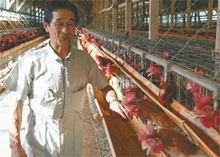Japanese farmers use rice as chicken feed

The yolk of an egg laid by a hen fed mainly rice, left, is paler than the yolk of an egg laid by one that ate mainly corn. Eggs and meat from chickens that were raised on domestic feed rice are drawing a great deal of attention lately, both as delicious cuisine and a way to help increase Japan’s self-sufficiency in food.
One of the most popular items on the menu at the Rana Cru cafe restaurant in Tsukuba, Ibaraki Prefecture, is a rice omelet priced at 850 yen. Staff at the restaurant said many customers have asked why the omelet is “white.” The answer is that, in general, the colour of egg yolks changes according to what the chicken ate. Most chickens are fed with imported corn; therefore the yolks of their eggs are vivid yellow. But if chickens eat feed that consists mostly of rice, the yolks become paler.
“Everybody’s surprised by this explanation,” said Rana Cru manager Yusuke Yonezawa. The eggs used at the restaurant are produced by Seiyo Obata on his chicken farm in Ibarakimachi, Ibaraki Prefecture. Two years ago, when prices of imported corn soared, he began using locally produced rice for feed. The egg-laying rates on his farm have not changed, and consumers have praised the eggs as having a light, delicious flavour.
Obata’s eggs are also sold in Tokyo, through the consumer cooperative Tohto Co-op, under the brand name Sanchoku Esamai Tamago. A pack of six eggs is priced at 198 yen.
“Using feed rice meets the needs of consumers who are highly conscious about food safety,” Obata said. “It can also help revitalize local communities.”
Despite the comparatively high price of eggs from chickens fed with rice, there have been successful attempts to develop local brands, such as Kometama eggs produced by a chicken farmers cooperative in Aomori Prefecture and Toyo no Kometamago eggs from Suzuki Poultry Farm Co. in Oita Prefecture.
Given their success, more chicken farms are likely to use feed rice in the future. The increasing use of feed rice is expected to raise this nation’s self-sufficiency in food. Though 96 percent of chicken eggs are produced domestically, about 90 percent of the feed for the chickens comes from imports.
“The Japanese livestock industry’s most important task is to escape from its reliance on imported feed,” said Seiji Nobuoka, an associate professor of Tokyo University of Agriculture. “I want consumers to understand the significance of introducing rice as livestock feed.”
Join 31,000+ subscribers
Subscribe to our newsletter to stay updated about all the need-to-know content in the poultry sector, three times a week. Beheer
Beheer











 WP Admin
WP Admin  Bewerk bericht
Bewerk bericht